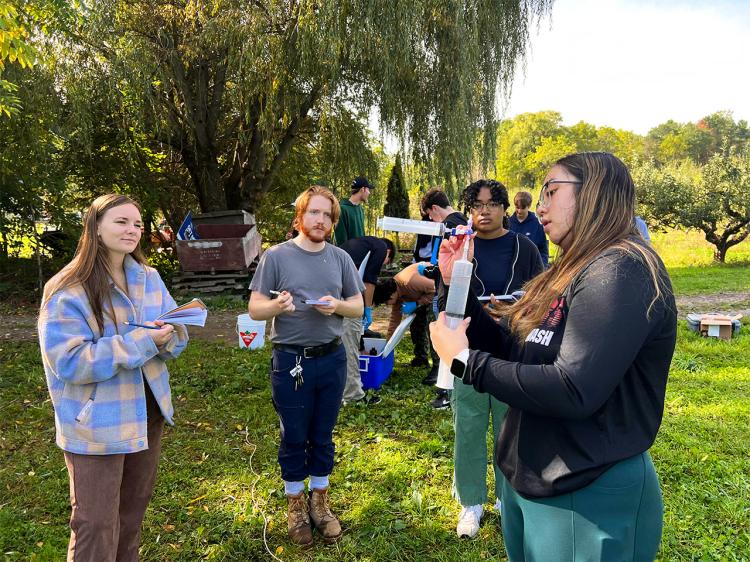When it comes to tackling the instability that climate change causes to communities, Brock University's next generation of scientists is gaining the first-hand experience needed to make a tangible impact.
As farmers move away from conventional fertilizers and toward more sustainable agricultural practices, for example, Brock environmental chemistry students have been studying the impacts of different farming methods on nearby ecosystems.

Brock students recently learned how to measure carbon dioxide in the water at an organic fruit farm in the Niagara region. From left are third-year Chemistry student Sierra Fitzsimmons, fourth-year Chemistry student Jack Comerford, third-year Chemistry student Abegail Tomlinson and fourth-year Concurrent Education student Julie Ho.
Last fall, they sampled water, soil and vegetation collected from the Fonthill Family Fruit Farm to evaluate the impact of applying organic copper spray on local waterways, such as the Twelve Mile Creek. This is a vital habitat for brook trout, an indicator species for the health of cold-water stream ecosystems.
"This CHEM 2P43 course, and the integration of the lab and the practical hands-on experience for our students, is the first of its kind in the chemistry department," says Assistant Professor of Chemistry Vaughn Mangal. "Students got into the field, gathered real-world data and then translated that data using advanced, sophisticated instruments to make sense of how contaminants are moving in their own backyard."
After applying the spray - used to protect against various fungal and bacterial diseases - students used the department's newly acquired inductively coupled plasma mass spectrometer to assess whether the compound had spread beyond the application site.
Although currently allowed for use in organic production, copper can potentially negatively impact wildlife populations.
"The outlet of the stream we tested had significantly more copper post-spray, proving that as water passes through the farm, it also picks up copper," says Isabelle Mowbray (BSc '25), who worked on the project.
Farm owner/operator Adam Gabourie says the results provided him with research-supported insight to help guide his operations as an organic farmer.
"It confirmed that moving beyond conventional organic fruit production measures in favour of a completely natural approach is much better practice for the nature of this site and the environment in general," he says.
The lab group is preparing the results of this research for future publication and plans to continue working with Gabourie on additional research.
Students in Brock's Surface Hydrology course worked on a project with the St. Catharines Downtown Association to assess the impact to nearby soil due to flooding on St. Paul Street after high-intensity rainfall events.
The project was supported by 2024 funding from the Government of Canada's Innovative Work-Integrated Learning Initiative, distributed through CEWIL Canada's iHUB.
In total, the program saw 526 Brock students across all Faculties receive more than $692,408 in direct and indirect support for work-integrated learning across 17 project-based grants and a University-wide bursary. Brock students may be eligible for funding through Brock's Co-op, Career and Experiential Education (CCEE) team.
Also supported by the funding was the ERSC 4P61 - Surface Hydrology course. Students worked on an urban hydrology and modelling project with the St. Catharines Downtown Association to assess the flooding on St. Paul Street from high-intensity rainfall events.
"One of the key issues with urbanization is there is a lot of paved area, which is completely impermeable," says Assistant Professor of Earth Sciences Kelly Biagi. "So, it's very common to get flooding in cities after large rain events because the water doesn't have anywhere to go."
Using collection buckets and a monitoring tool called a pressure transducer, students measured soil properties to understand their infiltration capacity and quantified the amount of water delivered for each rain event. Students were then able to determine which rain events are more likely to cause urban flooding.
This data provides the basis needed to understand which sustainable solutions could mitigate damage to properties and ensure accessibility to local businesses.
"This gave the Downtown Association a better understanding of the type of mitigation strategy they should look at implementing," says Biagi. "One option is a rain garden, where you replace a standard grass area with higher infiltration soil immediately under the eavestroughs to absorb a lot of the water that would otherwise be flooding the sidewalks and streets."
Haoran Chen (BSc '25) says participating in the course gave him the "chance to conduct field experiments and tackle real-world problems."
"It also introduced us to new hydrology software, which solidified my passion for hydrology and environmental conservation," he says.
Biagi plans to bring her next cohort of students back to the site in the fall to compare measurements and see the impact of the rain garden once installed.
Chris Bittle, Member of Parliament for St. Catharines, says CEWIL Canada funding is critical to supporting transformative learning experiences with community impact.
"CEWIL Canada funding is essential to expanding fair access to hands-on learning opportunities, while also connecting our community with innovative, research-based solutions" he says. "Our government is committed to supporting research that builds stronger, more sustainable communities and prepares the next generation to take on the complex challenges we face now and in the future."
To learn more or to apply for funding, visit the CCEE website.













